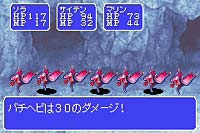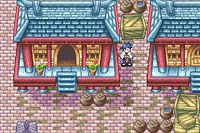Magical Houshin Review
Over the years I have picked up all sots of games with the intent to play, only to get distracted by one thing after another. This particular game, Magical Houshin, sat on a shelf in four different apartments over the course of a decade before I finally got around to it. While it is not a hidden gem as such, it is at least an interesting diversion in my Game Boy Advance backlog.
Magical Houshin is the sort of sequel no one really asked for, telling a story that continues from the events of its better known predecessor, Houshin Engi, and running perpendicular to its GameCube sibling, Battle Houshin. Set one thousand years after the great war of Houshin Engi, the main plot is never really allowed to progress beyond “old villain is getting revived, so stop it.” This isn’t for lack of trying, as there are plenty of optional secondary plots to discover, but in retrospect it’s obvious that the developers at Quintet were handed a main plot concept with little leeway available. Magical Houshin is barely more than a ten-hour game, even with the optional padding, and that feels like a waste of the potential inherent to the wuxia fantasy of its premise.
At least graphically it fits. Quintet was always a dab hand at pixel sprite graphics, and it shows in the variety of sprite animations, the monsters in combat, and even in the way the protagonist impatiently taps his foot if the player is idle for a few seconds. Everything fits back into the pseudo-historical Chinese aesthetic of the original Houshin Engi. The only thing really missing from the graphics are the heroes in battle, as the game takes an early Dragon Quest style approach that shows only the monsters and the attacks done upon them.
There is a variety of attacks to be had. Each of the characters eventually learns a series of different kung-fu moves and chi powers, but the bulwark of combat comes courtesy of the series’ signature item set, the Pao-Pei. These artifacts are empowered with a mystic force that allows their bearers to perform extraordinary feats in battle. The fact that the protagonist can make them is the plot point that sets off the entire adventure, and the main goal for the various side events is to eventually gather all the Pao-Pei scrolls containing instructions for their manufacture. Throughout the towns, forests, and dungeons, strange and esoteric ingredients may be found for use in Pao-Pei construction. Locating new scrolls, as well as the proper ingredients, is crucial for advancing through the enemy hordes.
And here is where the game’s annoying point comes in. Any given Pao-Pei requires one out of a dozen mystic phrases to be chanted during the process of creation. Simply knowing which one is not enough; the wayward souls echoing the individual phrases for all eternity must be sought out to discover the beat and meter in which to say them. The exact length of a spoken phrase is not always obvious from a simple reading, but it determines how long the player must wait between starting the process of Pao-Pei creation and ending it. Poor timing results in a bogus item. So, although the GBA lacks a microphone, the player will find themselves talking at the game quite a bit, just to ensure success.
To anyone considering this game, it is recommended to play it either on an original GBA or a Nintendo DS, to avoid issues with the availability of proprietary headphones. The mystic phrases aren’t the only auditory elements in general gameplay. There are some locations or one-off events that will influence the heroes’ fortunes for better or for worse, and often the only clue is either ghostly laughter or sobbing. Likewise, it is very easy to miss the clues for certain phrase locations with the sound off. The game’s soundtrack is not too shabby either, for a GBA title.
Magical Houshin has the unfortunate honor of being the next-to-last game that Quintet ever produced (the final nail being a Full Metal Alchemist title), and it’s a sad sign of what the studio had been reduced to by that point. While there are still signs of the whimsy, creativity, and outright oddity that characterized Quintet’s earlier output, the game is still a generic, by-the-numbers JRPG in all major metrics. It’s worth a look if you’re into obscure GBA titles, but there’s better to be had.


Creative in small doses
Some good sound direction
Decent combat design
Game-by-numbers design
Forgettable main plot
Item creation too quirky












Recent Comments